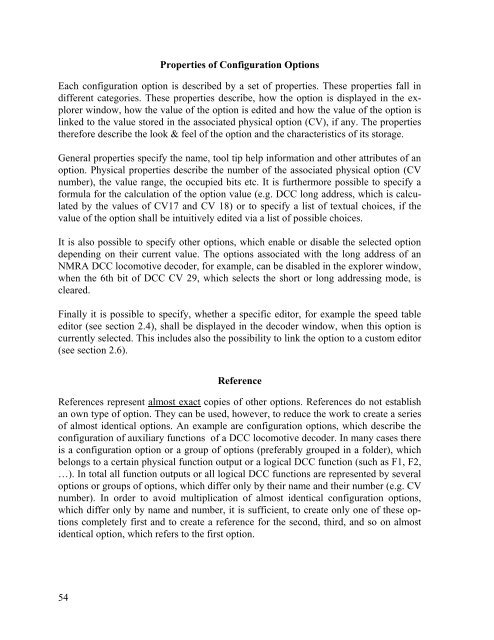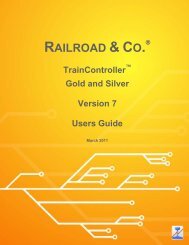Download - Freiwald Software
Download - Freiwald Software
Download - Freiwald Software
You also want an ePaper? Increase the reach of your titles
YUMPU automatically turns print PDFs into web optimized ePapers that Google loves.
54<br />
Properties of Configuration Options<br />
Each configuration option is described by a set of properties. These properties fall in<br />
different categories. These properties describe, how the option is displayed in the explorer<br />
window, how the value of the option is edited and how the value of the option is<br />
linked to the value stored in the associated physical option (CV), if any. The properties<br />
therefore describe the look & feel of the option and the characteristics of its storage.<br />
General properties specify the name, tool tip help information and other attributes of an<br />
option. Physical properties describe the number of the associated physical option (CV<br />
number), the value range, the occupied bits etc. It is furthermore possible to specify a<br />
formula for the calculation of the option value (e.g. DCC long address, which is calculated<br />
by the values of CV17 and CV 18) or to specify a list of textual choices, if the<br />
value of the option shall be intuitively edited via a list of possible choices.<br />
It is also possible to specify other options, which enable or disable the selected option<br />
depending on their current value. The options associated with the long address of an<br />
NMRA DCC locomotive decoder, for example, can be disabled in the explorer window,<br />
when the 6th bit of DCC CV 29, which selects the short or long addressing mode, is<br />
cleared.<br />
Finally it is possible to specify, whether a specific editor, for example the speed table<br />
editor (see section 2.4), shall be displayed in the decoder window, when this option is<br />
currently selected. This includes also the possibility to link the option to a custom editor<br />
(see section 2.6).<br />
Reference<br />
References represent almost exact copies of other options. References do not establish<br />
an own type of option. They can be used, however, to reduce the work to create a series<br />
of almost identical options. An example are configuration options, which describe the<br />
configuration of auxiliary functions of a DCC locomotive decoder. In many cases there<br />
is a configuration option or a group of options (preferably grouped in a folder), which<br />
belongs to a certain physical function output or a logical DCC function (such as F1, F2,<br />
…). In total all function outputs or all logical DCC functions are represented by several<br />
options or groups of options, which differ only by their name and their number (e.g. CV<br />
number). In order to avoid multiplication of almost identical configuration options,<br />
which differ only by name and number, it is sufficient, to create only one of these options<br />
completely first and to create a reference for the second, third, and so on almost<br />
identical option, which refers to the first option.










